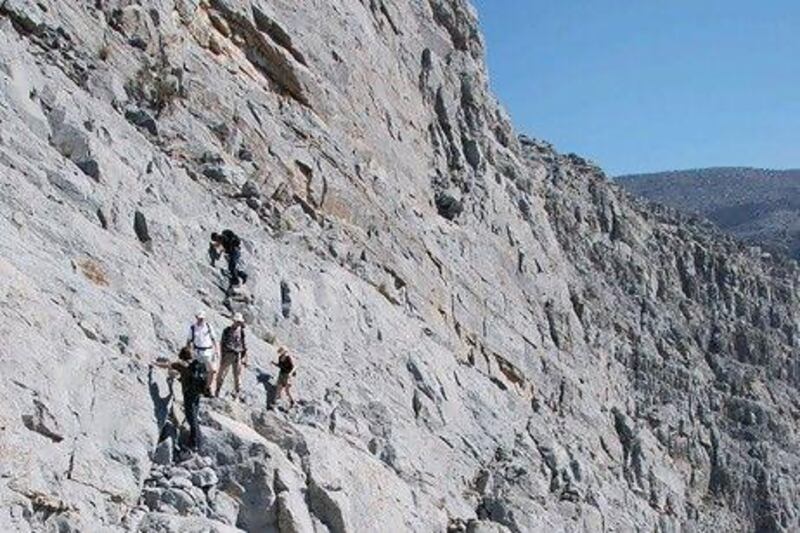DUBAI // The rules seem simple enough: never try to climb the 1,930-metre Stairway to Heaven without someone who knows it well, and never go unprepared in fitness or equipment.
But that common-sense advice has taken on new urgency after a British Emirates Airline pilot, aged 31, fell from the treacherous route in Ras Al Khaimah’s Hajar Mountains this week.
Aiden Laffey, 39, an Irish engineer, learned the route from experienced hikers, and says there are three important pieces of equipment to remember.
“There are many products on the market that can assist but the very basic is a fully charged phone, a route card left on the ground detailing when you’ll be back and where you’re going, and water,” he said. “It’s a well-established route and everyone knows it.”
Many who have tried the climb say they were lucky to return safely.
Andrew Miller, 28, no stranger to taking risks, said he had rarely felt fear like that on the Stairway last December when he made the 12-hour hike to the top.
“It was a mistake,” he said.
Mr Miller, an online marketing executive, has bungee jumped, skydived and completed parts of the Appalachian trail in the US and Peru’s famous Machu Picchu.
Mr Miller first learnt of the route in the Off Road Explorer guide book and heeded its warning as much as he could. A tour group he found online gave him advice he wasn’t expecting – don’t do it.
He convinced his American friend, Joey Caruso, 28, to go along but he was having doubts before they made the trip.
“I did a lot of rock climbing in college and I love the outdoors. I’m always up for something new and I love doing that kind of stuff,” Mr Caruso said.
The hike, they both agreed, got scary once they hit the stairways after five hours of tough hiking up unforgiving terrain. “Those stairways are made by man. I trust nature,” Mr Miller said. The stairways are paths built of stone between cliffs.
“We couldn’t find the actual stairway and once we saw it, it looked like it went straight up a flat cliff face,” Mr Caruso added.
For the next seven hours they were filled with fear. “It was tear-jerkingly terrifying. It’s not like other hikes. Machu Picchu has a metal rail. It’s very exposed. About 80 per cent of it to your right is a drop to your death,” Mr Miller said.
“The scariest part was halfway up and it was only a foot wide (30cm) and you had to stick your butt out over the ledge to get around a pass. It was not fun. I would not recommend it,” Mr Miller said.
Mr Caruso felt the same. “I’ve never been faced with so much fear but there was a sense of accomplishment at the same time. At the top, the ledge would be only a foot wide. Any wrong move and that was it,” he said. At one stage Mr Miller got stuck on a ledge. “You can easily get stuck. You think you have a shortcut and find it a dead end,” Mr Miller said.
People were going to do it, they should go with a group with at least one person who is confident of the route, he added.
Kyle Webber, a 26-year-old research engineer from the US, said he still wanted to climb it and add it to his treks in Malaysia and the US. “I’ve never done anything like that here in the desert environment. We are going to do a few other routes before attempting it,” he said.
“We would need a guide and would pay what would be required. It would have to be well mapped out and everybody knew what to do and authorities and friends on the ground know.”
Michael Richardson, a 27-year-old accounts payable manager, said: “I would do it again but only with a guide that was very familiar with the route. I would never venture out there by myself again. There are just too many opportunities to get lost or cause serious harm to yourself if you don’t know exactly where to go.”
Mr Laffey said there were also distress signal devices on the market, which send a location to the nearest rescue station before the trip.
He also stressed that those who still want to try the climb should do so in a group with at least one member who was confident in their knowledge of the route.
eharnan@thenational.ae






